Ségolène Royal loses the election for the first female president of the Republique Française, Nicolas Sarkozy enters the Palais Elysée as the winner and great hope. I experienced this moment on the Canal du Midi, on a trip in a houseboat through the Languedoc. Exactly five years have passed since then. Again I am on a houseboat, again on the Canal du Midi, and again the president is elected. This time Nicolas Sarkozy is fighting against a new hopeful, François Hollande, the ex-husband of Ségolène Royal. Little has changed in five years. Too little, in a country that, in the tradition of royal omnipotence and revolution, is seeking a way in the globalised world. Only hope has remained.
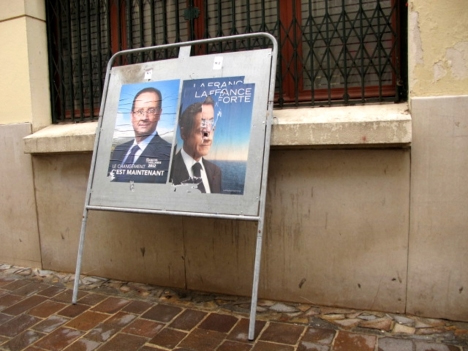 |
| The election campaign is over (Photo: Peter Züllig) |
As the boat glides slowly along the canal, which was built more than 300 years ago, through vast vineyards (maximum speed eight kilometres per hour), past washed-out banks and ailing plane trees, I realise how little has changed here in five years. Time really seems to have stood still. Only the lock keepers are now equipped with an electronic control system. Every now and then, bare, brown-grey fields present themselves amidst the vines. Vines have been uprooted here, their yield was too small, the incentive to collect the EU's uprooting premiums too great. People continue to live on hope and the conviction that the Cathars once defied the powers that be. The fact that they perished in the process has not been forgotten, but it is pushed away, far away.
Again and again the question arises: Who still drinks all the wine that is produced here year after year, in huge quantities? What can guarantee the winegrowers - whole villages live from winegrowing - a secure income? The runaway premiums are quickly used up, what comes next?
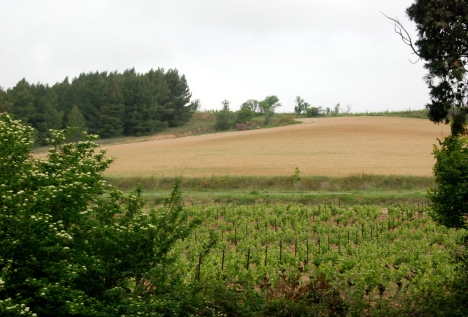 |
| Bare fields - vines once stood here (Photo: Peter Züllig) |
The canal, the former "main road" through the Languedoc, is lined with boat tourists. The "simple life" on the pénichettes (as the long, narrow barges are called) is becoming more and more comfortable: hot water, refrigerator, heating, television, geraniums... But otherwise - immediately to the right and left of the canal - little has changed. Everywhere old, often dilapidated houses, flats and plots of land - "à vendre", for sale. Only when you enter one of the small wine shops along the canal or order a wine in one of the restaurants waiting for tourists does a small change show up, which actually only the wine lover registers. The simple "vin de pays", the cheap or mass wine, has retreated, probably to the traditional bistros of the locals.
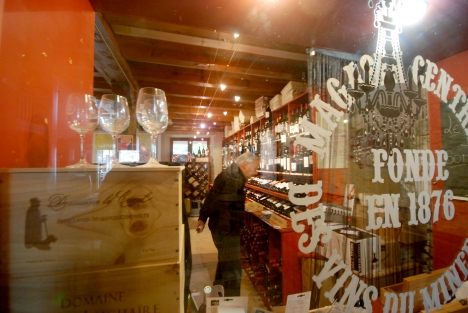 |
| Presentation of local wines on the Canal du Midi in Homps (Photo: Peter Züllig) |
Along the canal, the wine offer has clearly improved. Almost exclusively wines from the region are presented. On every wine list you will find good wines, at reasonable prices, and not only those that are well known and make the wine list look chic. There is obvious pride in what is produced in the village in the area and hopes to finally be perceived as a sophisticated wine region. The old image of only being a supplier of mass-produced and cheap products persists. But it can no longer be maintained. Even simple country wines show themselves not only with beautiful, mostly modern labels. They are surprisingly good and still reasonably priced. People want to make independent wines and no longer compete with the cheap wines from abroad that have been "flooding" not only the coast, but the whole country for years. It has been recognised that good and above all independent wines can also be made from the traditional grape varieties Syrah, Carignan, Mourvèdre and Cinsault.
Of course, there is still a tendency to strip away the old wine tradition of the Languedoc and introduce grape varieties that are widespread worldwide. It is mainly globalists from other French wine regions who want to take advantage of the excellent terroir of the south and - sometimes with large investments - bring the mainstream, especially Cabernet, Merlot, even Pinot Noir to the area. But their wines - usually quite expensive - are too high-priced for the region and therefore really only intended for tourists and export.
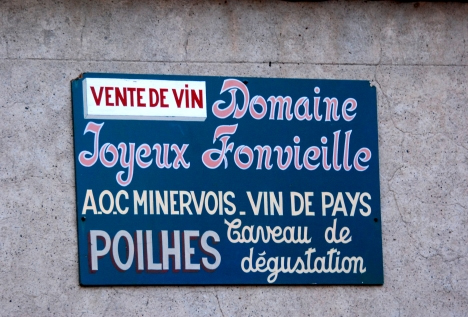 |
| One of the many advertising boards along the canal (Photo: Peter Züllig) |
Directly along the canal, wineries and small wine bars try to attract the passing ships. This is not easy, as mooring and mooring often require time and skill. In Ventenac d'Aude we let ourselves be "seduced" and moor directly in front of the imposing façade of the Ventenac-Minervois cooperative. It is shortly before noon - the doors close for two hours: Lunchtime. Three ships have docked. They have to wait until the doors open again. We wait, but the offer is a disappointment. In the red wine section, three traditional wines, only one of them not aged in barriques. The rest of the red wine selection: Merlot, Cabernet, Bordeaux assemblages... All this at a price of around seven euros. One still believes the augurs who fib about "big business" and want to make a second (more southern) Bordeaux out of the Languedoc. A second-class Bordelais, so to speak. Mondavi tried it years ago, and many Bordeaux players already have a leg up in the Languedoc.
Some winegrowers, including cooperatives, have now realised: There is a market between the simple wines and the mostly outdated fashionable wines - there is the market of the good terroir wine: independent grape variety, careful work in the vineyard, traditional and clean vinification and no squinting at what is fashionable at the moment.
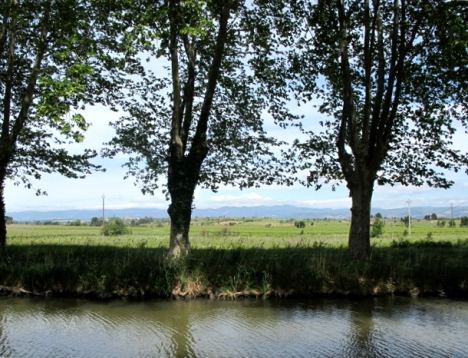 |
| The ship glides for hours through huge vineyards (Photo: Peter Züllig) |
I am convinced: Cabernet, Merlot and the like are not the way to go. The winemaking philosophy and tradition here in the Languedoc has been different for many generations: on the one hand, cooperative viticulture, where for a long time (too) much responsibility was delegated to a collective; on the other hand, a distinctive individuality, personalities who are quite capable of making distinctive wines of their own and are proud of it. Only - wine marketing has hardly relied on these latter qualities so far. People too often look for happiness in the more attractive price for something that others can often do better and for which they have far more funds available for investments (in the vineyard and in the cellar). So far, the Languedoc has almost suffocated from this inner conflict.
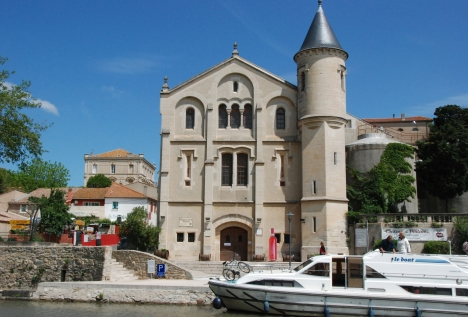 |
| The Château of Ventenac attracts boat tourists with its wine cellar (Photo: Peter Züllig) |
A class society is beginning to establish itself - similar to Bordeaux. The "well-behaved" nameless winegrowers (and cooperatives) for whom time has really stood still, and the stars who can market their wines worldwide. And in between? This in-between field is getting bigger and bigger and more self-confident, more and more independent and thus better and better. This "middle field" embodies what could make the survival of viticulture in the Languedoc possible, probably even possible.
Seen from the slowly gliding ship, time really seems to have stood still. The view of the huge vineyards - which have hardly changed - reinforces this impression. But those who are open to lesser-known, traditional, but clean, even lovingly made wines, are convinced - as I am - that time has not stood still in the Languedoc after all.
Sincerely
Yours/Yours